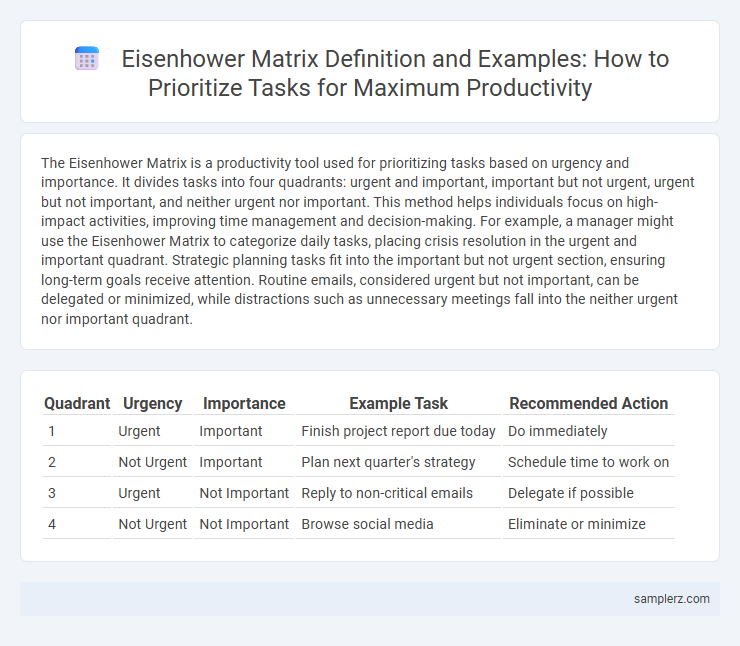The Eisenhower Matrix is a productivity tool used for prioritizing tasks based on urgency and importance. It divides tasks into four quadrants: urgent and important, important but not urgent, urgent but not important, and neither urgent nor important. This method helps individuals focus on high-impact activities, improving time management and decision-making. For example, a manager might use the Eisenhower Matrix to categorize daily tasks, placing crisis resolution in the urgent and important quadrant. Strategic planning tasks fit into the important but not urgent section, ensuring long-term goals receive attention. Routine emails, considered urgent but not important, can be delegated or minimized, while distractions such as unnecessary meetings fall into the neither urgent nor important quadrant.
Table of Comparison
| Quadrant | Urgency | Importance | Example Task | Recommended Action |
|---|---|---|---|---|
| 1 | Urgent | Important | Finish project report due today | Do immediately |
| 2 | Not Urgent | Important | Plan next quarter's strategy | Schedule time to work on |
| 3 | Urgent | Not Important | Reply to non-critical emails | Delegate if possible |
| 4 | Not Urgent | Not Important | Browse social media | Eliminate or minimize |
Understanding the Eisenhower Matrix in Productivity
The Eisenhower Matrix categorizes tasks into four quadrants based on urgency and importance, enabling effective prioritization by focusing on high-impact activities first. Tasks in Quadrant I are urgent and important, requiring immediate attention, while Quadrant II tasks are important but not urgent, promoting strategic planning and long-term productivity gains. Implementing the Eisenhower Matrix helps reduce time spent on low-priority tasks in Quadrants III and IV, improving overall efficiency and goal achievement.
The Four Quadrants: A Framework for Effective Prioritization
The Eisenhower Matrix divides tasks into four quadrants based on urgency and importance: Quadrant 1 includes urgent and important tasks requiring immediate attention, while Quadrant 2 focuses on important but not urgent activities that promote long-term goals. Quadrant 3 contains urgent but less important tasks that can be delegated, and Quadrant 4 covers neither urgent nor important tasks that should be minimized or eliminated. This framework enhances productivity by helping individuals prioritize effectively, ensuring critical tasks receive focus and time is not wasted on low-value activities.
Real-World Examples of Eisenhower Matrix in Action
The Eisenhower Matrix categorizes tasks into urgent-important, urgent-not important, not urgent-important, and not urgent-not important to optimize decision-making. In real-world settings, executives prioritize critical business meetings and project deadlines in the urgent-important quadrant, while delegating routine administrative tasks to avoid time wastage. This strategic task management enhances productivity by ensuring focus on high-impact activities that drive organizational success.
Urgent and Important Tasks: What to Address First
The Eisenhower Matrix categorizes tasks based on urgency and importance, emphasizing that urgent and important tasks demand immediate attention to prevent crises, missed deadlines, or significant setbacks. Prioritizing these tasks ensures efficient time management and maximizes productivity by addressing critical responsibilities first. This method helps in avoiding burnout by distinguishing between pressing issues and less critical activities.
Distinguishing Between Important and Non-Urgent Activities
The Eisenhower Matrix categorizes tasks into four quadrants, emphasizing the distinction between important and non-urgent activities to enhance productivity. Prioritizing tasks in the "Important but Not Urgent" quadrant enables long-term goal achievement and reduces stress by preventing last-minute crises. Effective use of this matrix improves time management by focusing efforts on strategic planning and personal development rather than reactive task completion.
Delegating Tasks: Utilizing the “Urgent but Not Important” Quadrant
Tasks in the "Urgent but Not Important" quadrant of the Eisenhower Matrix, such as routine emails or scheduling meetings, are ideal for delegation to free up time for high-impact activities. Effective delegation involves identifying team members with the right skills to handle these tasks efficiently while maintaining clear communication and expectations. This practice enhances overall productivity by allowing focus on strategic goals without neglecting necessary but less critical duties.
Eliminating Distractions: The “Not Urgent, Not Important” Quadrant
The "Not Urgent, Not Important" quadrant of the Eisenhower matrix emphasizes eliminating distractions such as excessive social media, irrelevant emails, and non-essential tasks that consume valuable time without contributing to productivity. Prioritizing this quadrant encourages focusing on high-impact activities by minimizing engagement with low-value interruptions that hinder workflow efficiency. Effective time management involves regularly identifying and removing these distractions to enhance overall task prioritization and goal achievement.
Daily Planning with the Eisenhower Matrix
The Eisenhower Matrix divides tasks into four categories: urgent and important, important but not urgent, urgent but not important, and neither urgent nor important, enabling effective daily planning. Prioritizing tasks in the urgent and important quadrant ensures critical deadlines are met, while scheduling important but not urgent activities enhances long-term productivity. Delegating or eliminating less essential tasks frees time for focused work, optimizing daily output and reducing stress.
Tips for Integrating the Matrix into Your Workflow
Incorporate the Eisenhower Matrix into your daily routine by categorizing tasks into four quadrants: urgent and important, important but not urgent, urgent but not important, and neither urgent nor important. Use digital tools or physical planners to visualize and regularly update task priorities, ensuring focus remains on high-impact activities. Set specific time blocks for Quadrant 2 activities to prevent urgent tasks from monopolizing your schedule and boosting long-term productivity.
Common Mistakes to Avoid When Using the Eisenhower Matrix
Common mistakes to avoid when using the Eisenhower Matrix include misclassifying tasks by urgency instead of importance, which leads to ineffective prioritization. Ignoring scheduled reviews of the matrix results in outdated task management that hampers productivity. Overloading the "Important and Urgent" quadrant can create unnecessary stress and reduce focus on long-term goals.

example of Eisenhower matrix in prioritization Infographic
 samplerz.com
samplerz.com